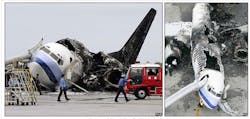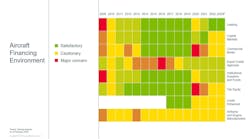Trainers are always looking for examples of human or organizational performance that contributed to an incident/event. Johnson characterizes and shows example events that provide the best opportunity to learn.
Background
I started teaching human factors contribution to accidents around 1980. With a fresh Ph.D. diploma, I was teaching an accident investigation course at the University of Illinois. I could not have imagined that I would be so fortunate as to still be “telling accident stories” nearly 40years later. Of course, the example cases have changed as aviation safety has evolved. The hardware failures have diminished the increasing attention to human error as a contributing factor. Pre-1980 accidents, like the Hindenburg may have historical value and even human factors examples. However, the old accidents lack necessary modern relevancy. Dual engine failure on a 777, fuel exhaustion and dead stick landing on an A330, flight controls on a Beech 1900 commuter, or AS 350 helicopter, strike closer to home with today’s learners. What kind of events are best for maintenance human factors learning environment?
Characteristics of a Suitable Learning Example
First and foremost, we know that many events resulted in loss of lives. Always acknowledge that fact at the outset of post-event analysis. Second, company names are associated with events. A negative event must be fact-based and is not usually directly associated with the overall continuing quality and safety of parties involved. Mention that at the outset of a discussion. Third, assume that parties to the event may be in your audience. From experience, I have learned to ask that question before getting into the details of an accident. I have had audience members who serviced and or flew the event aircraft, knew the crew members, were at the accident scene, and may have lost family members or colleagues. For these reasons it is ideal to find accident examples where there were no injuries or fatalities. Further, surviving crew and aircraft can detail the circumstances surrounding the accident leading to the best understanding of contributing factors.
In a perfect world use an event directly matched to your audience. General aviation mechanics want to hear about GA accidents; airline mechanics want airliners, pilots want flightcrew-related contributing factors; and managers/executives need to hear about organizational factors. Because of the accident chain, one accident often addresses many audiences. Human error and organizational factors are generic. Safety culture is generic. Issues like failure to follow procedures, fitness for duty, and crew communication cross all industry segments.
Look for events where there are supporting pictures, graphics, or videos. In today’s YouTube world a trainer must be judicially selective about appropriate and legally available content. Published accident report data is usually the best source and publicly available. If it is in a government report it has cleared the hurdles of fact-checking, language appropriateness, and public-use suitability.
Example Learning Events that Work for Maintenance
The accident reports described below are easy to find via a quick Google search.
Example 1: Airbus A319, London Heathrow, May 24, 2013
The flight took off with unlatched cowlings on both engines. At take-off speed the cowlings detached damaging the fuel line on the right engine. The cowling damage leaking fuel was visually detected by passengers and reported to the cabin crew. This information was not adequately transmitted to the flight crew, badly affecting flightcrew decision-making. The left engine operated normally, with cowlings opened and no fuel leaks. On return to Heathrow the right engine caught fire and was shut down. The aircraft landed without further event and passengers disembarked through emergency exits. From takeoff roll to landing the time was nearly 24 minutes. See Figure 1 for open cowlings and emergency evacuation.
The A319 accident report, published by the CAA Air Accidents Investigation Branch, is about 120 pages long. This was a maintenance accident because, for a multitude of reasons, the maintenance crew did not secure the cowlings. The ground and flight crews also failed to notice the unlatched cowlings, an issue that created numerous previous events on this aircraft type.
Many of the maintenance actions leading to the event were associated with failure to follow procedures. They were working overnight on line maintenance. Lacking all necessary tools, aboard their truck, they postponed a service for later in the shift. Contrary to procedures, they left the cowlings opened and did not properly placard that condition in the aircraft. When they returned to the task, later in the shift, they went to the wrong aircraft. Noticing that the doors were closed they assumed that someone else completed the task. They double checked the work and closed the cowlings. The cowlings remained open on the first aircraft they had serviced.
The report outlines a number of organizational procedural errors, committed on a regular basis at that location. Further, the report suggested that the work schedules of the maintenance crew left them prone to fatigue and associated errors. It is a report worth reading and noting the errors by mechanics, ground crew, cabin crew, and pilots. It is an ideal learning tool for any human factors class.
Example 2: Eurocopter AS350, Near Las Vegas, NV, Dec. 7, 2011
The helicopter, on a sight-seeing tour with a pilot and four passengers, crashed about nine minutes after takeoff. It crashed into a canyon after complete loss of control due to a failed flight control attachment for a primary servo. The nut, bolt, and locking mechanism were not found at the crash site. Serviced the night before the crash, it appeared that a self-locking nut was improperly reused and the additional locking split pin was not installed as per the procedures (See Figure 2). Neither the post-maintenance check pilot nor the pilot that flew two revenue flights, prior to the accident flight, noticed the missing locking hardware.
The contributing factors to this maintenance accident were the mechanics and inspector’s failure to follow maintenance procedures regarding locking mechanisms for critical flight controls. The NTSB concluded that there was a likely fitness for duty issue due to the altered work schedules of the mechanic and the inspector (See Figure 3 for actual work schedule). NTSB attributed blame to the quality of the organization's work cards, which did not contain sufficient detail. Finally, NTSB recommended that all of the maintenance workforce participate in human factors training.
Figure 3. The work schedule affecting mechanic and inspector fitness for duty.
Personnel Normal Shift Shift Originally Scheduled for Dec. 6 Actual Dec. 6 Shift
Mechanic 1200 to 2300 Off Duty 0550 to 1846
Inspector 1200 to 2300 Off Duty 0550 to 1846
Example 3: B-737, Air China 120, August, 2007, Okinawa, Japan
While taxiing to the gate after landing, ground staff observed fuel leaking from No. 2 engine pylon. Once stopped away from gate, the leaking fuel ignited. Passengers evacuated via emergency exits. Aircraft burned to total destruction. See Figure 4.
The 737-800 has four slats installed on the leading edge of each wing. Each slat rides on two auxiliary tracks. The slat tracks are housed in a track can, which extend into an aluminum housing in the fuel tank. At the fuel tank end of the main track is a downstop bolt that stops the track when it is extended fully forward. For this event the bolt was installed, in the field about 30 days prior to the accident, without the necessary washer to ensure that it stayed in place. The maintenance crew had failed to install the washer. See Figure 5. When the downstop assembly fell out of place it was pushed to the back of the track can and punctured a hole in the fuel tank. This failure to follow procedures error, for a small washer, lead to the aircraft loss.
Conclusions
Accident reports present many learning opportunities. The three examples described here are but many that show multiple human factors issues not only in maintenance but also with other crew members. Example 1 and 2 were from the accident reports. Example 3 came from the FAA website: Lessonslearned.faa.gov. That FAA site includes accidents from airlines, general aviation, and rotorcraft.


